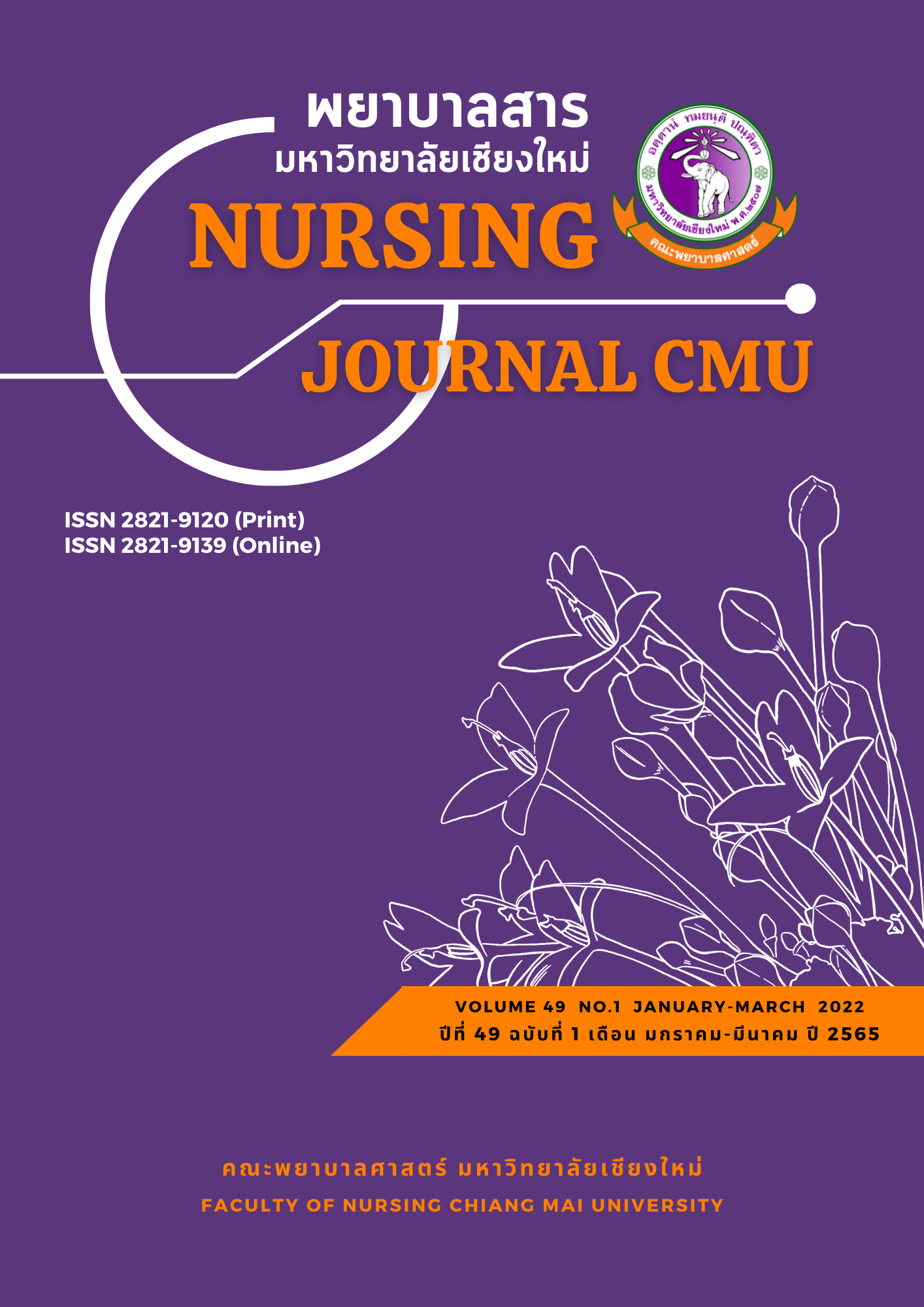Symptom Experiences and Abdominal Pain Management in Post Endoscopic Retrograde Cholangiopancreatography Patients
Keywords:
Experience abdominal pain, Abdominal Pain Management, Endoscopic Retrograde CholangiopancreatographyAbstract
Abdominal pain is the most common post endoscopic retrograde cholangiopancreatography (ERCP), resulting in suffering. This descriptive research aimed to study the incidence of abdominal pain in patients who have done ERCP, and explored the experience with abdominal pain management by pharmacological method and non-pharmacological method, including their outcomes. The samples consisted of 90 patients who have done the ERCP in internal medicine ward and surgical ward. The research instrument were five questionnaire consisting of 1) general information and medical data. 2) non-pharmacological management of abdominal pain after ERCP and outcomes 3) severity and frequency of abdominal pain 4) Health status post ERCP 5) Pharmacological pain management and outcome post ERCP. Data analysis were performed by descriptive statistics. The results showed as followed.
1. The incidence rate of abdominal pain after ERCP was 42.22 %
2. The severity of pain were moderate, severe pain, and mild in 20.00%, 13.33% and 8.89%, respectively. The frequency of abdominal pain were rarely pain, almost always pain, full time and sometime pain in 50% ,18.42%,18.42% and 13.16%, respectively.
3. The abdominal pain managements in patients after ERCP showed as follow,
3.1 Pharmacological and non-pharmacological method was 57.89 %.
Fentanyl was used the most and then morphine, pethidine and non-opioid respectively.
3.2 The patients who use only non-pharmacological method were 42.11%. The most used technique were psychological support and lying still., followed by stroking the pain area and relaxation techniques.
4. The results of abdominal pain managements for post ERCP patients showed as follow,
4.1 The result of pharmacological and non-pharmacological method showed that the patients received paracetamol, pethidine and patients who received more than one combination drug were 100% effectively. The patient received fentanyl and morphine wear 92.30% and 80.% effectively respectively
4.2 The result of non-pharmacological methods showed that psychological support was 75%
effectively, followed by stroking the pain area and lying still in 55%, and 41.70% effectively, respectively.
The results of this research suggest that nursing care programs for patients with abdominal pain post ERCP should be developed for effective nursing care in the future.
References
Atchalanan, N. (2021). Approach to patient with acute pancreatitis. (in Thai) Retrieved from
https://www.rama.mahidol.ac.th/med/sites/default/files/public/pdf/medicinebook1/Approach to patient with acute pancreatitis.pdf
Chen, M., Wang, L., Wang, U., Wei, W., Yao, YL., Ling, TS., …, Zou, XP. (2018). Risk factor analysis of post-ercp cholangitis: A single-center experience. Hepatobiliary & pancreatic diseases international. 17(1). 55-58. doi: org/10.1016/j.hbpd.2018.01.002
Chen, M., Zheng, R., Cao, J., Yao, YL., Wang, L., & Zou, XP. (2020). Risk factors for post-endoscopic retrograde cholangiopancreatography abdominal pain in patients without post-ERCP pancreatitis.1-15. doi:10.21203/rs.3.rs-40959/v1
Dodd, M., Janson, S., Facion, N., Faucett, J., Froelicher, E.S., Humphreys, J., … Taylor, D. (2001). Advance the science of symptom management. Journal of advance nursing, 33(5), 668-676.
Kochar, B., Akshintala, V. S., Afghani, E., Elmunzer, B. J., Kim, K. J., Lennon, A. M., … Sing, V. K. (2015). Incidence, severity, and mortality of post-ercp pancreatitis: A systematic review by using randomized, controlled trials. Gastrointestinal endoscopy, 81(1), 143–149.
Manoharan, D., Srivastava, D. N., Gupta, A. K., & Madhusudhan, K. S. (2019). Complications of endoscopic retrograde cholangiopancreatography: An imaging review. Abdominal Radiology New York, 44(6), 2205-2216.
Melzack, R., & Wall, D. P. (1965). Pain mechanism: A new theory. Retrieved from http://pcpr.pitt.edu/wp-content/uploads/2018/01/Melzack-Wall.pdf
Meseeha, M., & Attia, M. (2021). Endoscopic Retrograde Cholangiopancreatography. Retrieved from: https://www.ncbi.nlm.nih.gov/books/NBK493160/
Nanthana – Krienngkrai Chotiwatanaphan Institute of Gastroenterology and Hepatology. (2017). Statistics for ercp preparation. Songkhla: Songkhla Nakarin Hospital. (in Thai)
Ngamjarus, C. & Chongsuvivatwong, V. (2014). N4studies: Sample size and power calculations for iOS. The Golden Jubilee Ph.D. Program, The Thailand Research Fund & Prince of Songkla University. (In Thai)
Pimvara, P. (2015). How to manage acute pain. (in Thai) Retrieved from https://heritage.eau.ac.th/sci_journal/PDF/HeritageJournal/Heritage-9-02-58-Science.pdf
Sawangchai, J., & Ngamkham, S. (2017). Postoperative pain in patients after abdominal surgery at Sawanpracharak Hospital. Journal of Health Science Research, 11 (special issues), 1-11. (in Thai)
Soowit, B., Panasakulkan, S., & Muksiritipanun, B. (2015). The assessment of the suffering symptoms in palliative care patients. Songklanagarind Journal of Nursing. 35(1), 153-64. (in Thai)
Sprouse-Blum, A. S., Smith, G., Sugai, D., & Parsa, F. D. (2010). Understanding endorphins and their importance in pain management. Hawaii Medical Journal, 69(3), 70–71.
Statistical Medicine Unit. (2017). Statistics for ercp preparation. Songkhla: Songkhla Nakarin Hospital. (in Thai)
Tapsoowan, A. (2016). Nursing care for patients with common bile duct stone undergoing endoscopic retrograde cholangiopancreatography. Retrieved from https://www2.si.mahidol.ac.th/division/nursing/sins/attachments/article/229/A nursing guide for patients with bile duct stones undergoing endoscopic examination of the bile duct and pancreas.pdf. (in Thai)
Thai National Formulary. (2015). Anesthetics and pain medication. (in Thai) Retrieved from http://202.28.95.4/pharmacy/myfile/1_anesthetics_and_pain_medication_0.pdf
Tryliskyy, Y., & Bryce, G, J. (2018). Post-ercp pancreatitis: Pathophysiology, early identification and risk stratification. Advances in Clinical and Experimental Medicine. 27(1). 149-154. doi: 10.17219/acem/66773
Downloads
Published
How to Cite
Issue
Section
License
Copyright (c) 2022 Nursing Journal

This work is licensed under a Creative Commons Attribution-NonCommercial-NoDerivatives 4.0 International License.
บทความที่ได้รับการตีพิมพ์เป็นลิขสิทธิ์ของวารสารพยาบาลสาร
ข้อความที่ปรากฏในบทความแต่ละเรื่องในวารสารวิชาการเล่มนี้เป็นความคิดเห็นส่วนตัวของผู้เขียนแต่ละท่านไม่เกี่ยวข้องกับมหาวิทยาลัยเชียงใหม่ และคณาจารย์ท่านอื่นๆในมหาวิทยาลัยฯ แต่อย่างใด ความรับผิดชอบองค์ประกอบทั้งหมดของบทความแต่ละเรื่องเป็นของผู้เขียนแต่ละท่าน หากมีความผิดพลาดใด ๆ ผู้เขียนแต่ละท่านจะรับผิดชอบบทความของตนเองแต่ผู้เดียว






